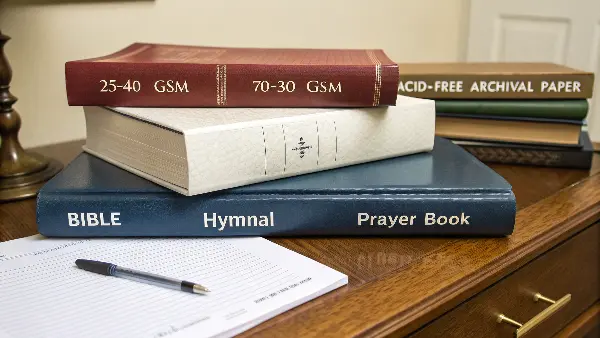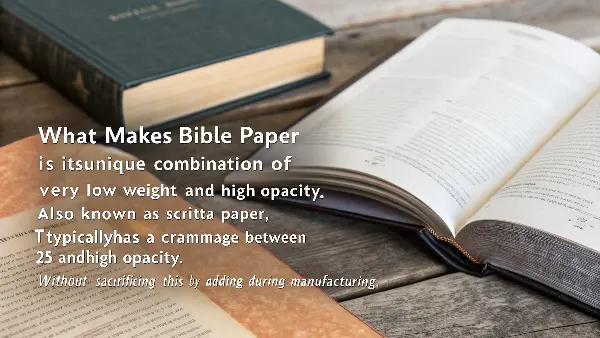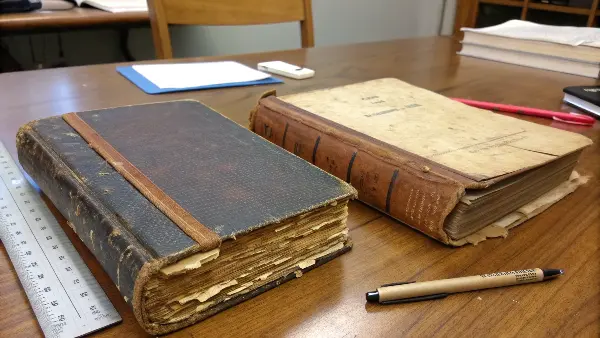Selecting the right paper for a religious text can feel overwhelming. You need it to be durable for daily use, but thin enough to contain a huge amount of text without becoming massive. Choosing the wrong paper can lead to ink bleeding through, pages tearing easily, and a book that feels cheap, failing the sacred text it holds.
To choose the right paper for religious publications, focus on three key factors: weight (GSM), opacity, and longevity. For Bibles, select a lightweight "Bible paper" (25-40 GSM) with high opacity to prevent bleed-through. For hymnals and prayer books, a heavier, more durable stock (70-90 GSM) is better to withstand frequent handling. Always opt for acid-free, archival-quality paper to ensure the book lasts for generations without yellowing or becoming brittle.

Choosing paper is about more than just feel; it’s about function, longevity, and respect for the content itself. A Bible is not like a novel, and a hymnal is not like a magazine. Each has unique requirements that demand careful thought. Let’s explore the specific details you need to consider to make the right choice for your project. This guide will help you navigate the technical aspects so you can create a publication that is both beautiful and built to last.
What Makes "Bible Paper" So Special and Different?
You’ve probably heard the term "Bible paper" before, but what does it actually mean? Many customers assume it’s just any thin paper, but choosing incorrectly can lead to a final product that is transparent and fragile. This mistake can ruin an entire print run, wasting time and money, and delivering a poor experience to the reader.
What makes "Bible paper" special is its unique combination of very low weight and high opacity. Also known as "scritta paper," it typically has a grammage between 25 and 40 GSM. This thinness is achieved without sacrificing opacity by adding mineral fillers like titanium dioxide or calcium carbonate during manufacturing. This process prevents the text from showing through, allowing thousands of pages to fit into a compact, readable book without being transparent or overly fragile.

When I first started in this business, I was fascinated by Bible paper. It seems to defy logic. How can something so thin be so strong and opaque? The secret is in the production process. Unlike standard office paper, the wood pulp is processed to create shorter, finer fibers. This creates a denser, more uniform sheet. Then, the mineral fillers I mentioned are added. These fillers are not just for bulk; they are highly reflective particles that scatter light, preventing ink from being visible on the reverse side.
Think of it like painting a thin wall. A single coat of regular paint might not cover the old color. But if you use a paint with high-quality pigments (like titanium dioxide), you get excellent coverage with just one thin layer. The same principle applies here. This allows publishers to print the entire text of a sacred book in a volume that is easy to hold and carry. Here is a simple breakdown:
| Feature | Standard Paper (e.g., 80 GSM) | Bible Paper (e.g., 30 GSM) |
|---|---|---|
| Pulp Fibers | Longer and less processed | Very short, fine, and highly refined |
| Fillers | Basic fillers like clay | High-performance fillers (Titanium Dioxide) |
| Result | Thicker, less opaque for its weight | Very thin, but surprisingly opaque |
| Primary Use | Office printing, notebooks, flyers | Bibles, dictionaries, encyclopedias |
So, when you are sourcing paper for a Bible or any large reference text, asking your supplier about the opacity rating and the type of fillers used is just as important as asking for the grammage (GSM). That’s how you ensure you are getting true Bible paper.
How Does Paper Weight (GSM) Affect a Bible or Hymnal?
Have you ever picked up a Bible that felt heavy and bulky, or a hymnal with pages so thin they seemed like they would tear with a single turn? This is often a problem of mismatched paper weight. The wrong GSM can make a book impractical for its intended use, whether that’s a personal Bible carried to church or a hymnal shared by a congregation every Sunday.
Paper weight, measured in Grams per Square Meter (GSM), directly impacts a publication’s thickness, durability, and feel. For a Bible, a low GSM (25-40) is essential to keep the book’s size and weight manageable. For a hymnal or prayer book, which sees more vigorous, repeated use, a higher GSM (70-90) is necessary. A heavier weight provides the durability needed to withstand constant page-turning and handling by many different people over many years.

The choice of GSM is a balancing act between portability and durability. I remember a project with a client who wanted to produce a beautiful family Bible. They initially leaned towards a thicker, creamier paper because it felt more premium. However, once we created a dummy book, they realized the final product would be nearly five inches thick and weigh a ton! It would have been a display piece, not a book for study and reflection. We switched to a 35 GSM archival-quality Bible paper, and the result was perfect—a substantial yet manageable book.
Conversely, for hymnals, durability is the top priority. Think about how a hymnal is used. It’s held open, passed around, and pages are flipped back and forth during a service. A thin paper would simply not survive. A sturdy 80 or 90 GSM uncoated paper is a much better choice. It has enough heft to lay flat on a music stand and enough strength to endure years of weekly use.
Here’s a quick reference for choosing the right GSM for different religious publications:
| Publication Type | Recommended GSM Range | Primary Consideration |
|---|---|---|
| Compact/Pocket Bible | 25-30 GSM | Maximum portability |
| Standard Pew Bible | 30-40 GSM | Balance of portability and text volume |
| Study Bible / Reference Bible | 35-50 GSM | Slightly thicker for notes and durability |
| Prayer Book / Missal | 60-80 GSM | Frequent handling, needs durability |
| Hymnal | 70-90 GSM | High durability, stiffness for music stands |
| Religious Children’s Book | 120-150 GSM | Resists tearing from small hands |
When you talk to your supplier, don’t just specify the GSM. Explain how the book will be used. Will it be carried daily? Used by a whole congregation? Kept on a shelf for generations? This context helps us recommend the perfect weight for your needs.
Why Is Opacity the Most Critical Factor for Thin Paper?
You’ve decided on a thin paper to keep your Bible compact, but now you have a new worry. Will the reader be distracted by the ghost of text from the other side of the page? This issue, known as bleed-through or show-through, can ruin the reading experience, making the text hard to focus on and giving the book a low-quality feel.
Opacity is the most critical factor for thin paper because it determines how much ink or text is visible from the reverse side. In religious texts with thousands of pages printed on both sides, high opacity is non-negotiable. Even with a lightweight paper (low GSM), high opacity ensures the text is crisp and legible. It prevents the distracting "ghosting" effect, providing a clean and reverent reading experience worthy of a sacred text.

Opacity is measured as a percentage. A paper that is 100% opaque is completely non-transparent. For Bible paper, you should aim for an opacity of 85% or higher. Anything less, and you risk show-through, especially with the dark, dense fonts typically used in Bibles. I once had a client who tried to cut costs by choosing a 30 GSM paper with only 80% opacity for a prayer book. The sample looked terrible. The text on both sides muddled together, making it almost unreadable. We had to switch to a paper with 90% opacity, which made all the difference.
So how is this high opacity achieved in such thin paper? As I mentioned earlier, it comes down to the fillers. Titanium dioxide (TiO2) is the star player here. It has a very high refractive index, meaning it is excellent at scattering light. When these fine particles are mixed into the paper pulp, they create a barrier that stops light from passing through the sheet, effectively hiding the ink on the other side.
Here’s how to think about it when sourcing your paper:
- For Bibles and Dictionaries: Thin paper is a must. Therefore, you must demand high opacity. Ask for paper with an opacity rating of at least 85-90%.
- For Hymnals and Study Guides: The paper is naturally thicker (70-90 GSM), so opacity is less of a concern. The paper’s own thickness provides a natural barrier. However, it’s still good practice to check that the opacity is sufficient.
- Printing Method Matters: The type of ink and printing press can also affect bleed-through. Discuss this with your printer to ensure the ink and paper are compatible. A quality supplier can provide paper engineered for specific printing methods.
Never compromise on opacity when printing a text-heavy book on thin paper. It is the single most important technical specification for ensuring readability and quality.
What Role Do Durability and Acidity Play in Paper Selection?
Imagine a cherished family Bible, passed down through generations, with pages that are yellow, brittle, and crumbling at the edges. Or a brand new hymnal that starts to look worn and faded after just a few years of use. These problems stem from poor paper durability and high acidity, which can undermine the purpose of creating a book meant to last.
Durability and acidity are crucial because religious publications are intended for long-term, repeated use over decades or even centuries. Choosing acid-free, archival-quality paper prevents it from yellowing and degrading over time. Durability, influenced by fiber length and paper weight, ensures the pages can withstand constant handling, folding, and turning without tearing. This guarantees the publication remains a usable and beautiful object for future generations.

The enemy of paper longevity is acid. Many older papers were made using wood pulp that contained lignin, a natural compound that breaks down into acid over time. This acid attacks the paper’s cellulose fibers, making them weak and brittle. That’s why books from the 19th and early 20th centuries often have that characteristic yellow, fragile paper. Modern archival-quality paper is "acid-free" or has an alkaline buffer (like calcium carbonate) added during production. This buffer neutralizes any acids that might form, giving the paper a lifespan of hundreds of years.
When I work with publishers of religious texts, I always stress the importance of using archival-grade paper. A client creating a commemorative edition of their church’s history was initially focused only on the look and feel. I explained that for a book meant to be a historical record, specifying "acid-free" and "archival quality" was essential. It adds very little to the cost but adds centuries to the book’s life.
Here are the key aspects of durability to discuss with your supplier:
| Durability Factor | What It Is | Why It Matters for Religious Texts |
|---|---|---|
| Acid-Free | Paper with a pH of 7 (neutral) or higher. | Prevents yellowing and degradation over time. Essential for any book intended to last. |
| Archival Quality | Acid-free paper made with higher quality, more durable materials, often with an alkaline reserve. | The highest standard for longevity, meant to last for centuries. Ideal for family Bibles and historical records. |
| Tear Resistance | The paper’s ability to resist tearing. Influenced by fiber length and processing. | Crucial for thin Bible pages and frequently used hymnals. |
| Folding Endurance | How many times a page can be folded before it breaks. | Important for pages that are turned often or have corners folded to mark a place. |
For a Bible, you need a delicate balance: a paper thin enough for portability but with enough fiber strength and tear resistance for daily use. For a hymnal, tear resistance and folding endurance are even more important. Always ask your supplier for the technical specifications on these durability metrics, and always insist on acid-free paper as your baseline.
Conclusion
Choosing the right paper is a foundational step in creating a religious publication that is respectful, functional, and enduring. It’s a balance of art and science. By focusing on the interplay between paper weight (GSM), opacity, and archival durability, you can make an informed decision. This ensures your Bible, hymnal, or prayer book serves its sacred purpose for many years to come.

